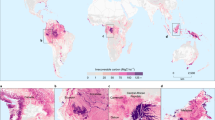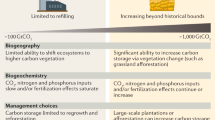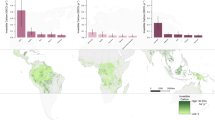Abstract
Avoiding catastrophic climate change requires rapid decarbonization and improved ecosystem stewardship. To achieve the latter, ecosystems should be prioritized by responsiveness to direct, localized action and the magnitude and recoverability of their carbon stores. Here, we show that a range of ecosystems contain ‘irrecoverable carbon’ that is vulnerable to release upon land use conversion and, once lost, is not recoverable on timescales relevant to avoiding dangerous climate impacts. Globally, ecosystems highly affected by human land-use decisions contain at least 260 Gt of irrecoverable carbon, with particularly high densities in peatlands, mangroves, old-growth forests and marshes. To achieve climate goals, we must safeguard these irrecoverable carbon pools through an expanded set of policy and finance strategies.
This is a preview of subscription content, access via your institution
Access options
Access Nature and 54 other Nature Portfolio journals
Get Nature+, our best-value online-access subscription
$29.99 / 30 days
cancel any time
Subscribe to this journal
Receive 12 print issues and online access
$209.00 per year
only $17.42 per issue
Buy this article
- Purchase on Springer Link
- Instant access to full article PDF
Prices may be subject to local taxes which are calculated during checkout




Similar content being viewed by others
Data availability
All data generated or analysed during this study are included in this published Perspective and its supplementary information files.
References
IPCC Global Warming of 1.5 °C: An IPCC Special Report on the impacts of global warming of 1.5 °C above pre-industrial levels and related global greenhouse gas emission pathways in the context of strengthening the global response to the threat of climate change, sustainable development, and efforts to eradicate poverty (eds Masson-Delmotte, V. et al.) (World Meteorological Organization, 2018).
Friedlingstein, P. et al. Global Carbon Budget 2019. Earth Syst. Sci. Data 11, 1783–1838 (2019).
Rockstrom, J. et al. A roadmap for rapid decarbonization. Science 355, 1269–1271 (2017).
Anderson, C. M. et al. Natural climate solutions are not enough: decarbonizing the economy must remain a critical priority. Science 363, 933–934 (2019).
Griscom, B. et al. We need both natural and energy solutions to stabilize our climate. Glob. Change Biol. 25, 1889–1890 (2019).
Turner, W. R. Looking to nature for solutions. Nat. Clim. Change 8, 18–19 (2018).
Griscom, B. W. et al. Natural climate solutions. Proc. Natl Acad. Sci. USA 114, 11645–11650 (2017).
Busch, J. et al. Potential for low-cost carbon dioxide removal through tropical reforestation. Nat. Clim. Change 9, 463–466 (2019).
Fargione, J. E. et al. Natural climate solutions for the United States. Sci. Adv. 4, eaat1869 (2018).
McGlade, C. & Ekins, P. The geographical distribution of fossil fuels unused when limiting global warming to 2 °C. Nature 517, 187–190 (2015).
Dinerstein, E. et al. An ecoregion-based approach to protecting half the terrestrial realm. Bioscience 67, 534–545 (2017).
Li, Y. et al. Local cooling and warming effects of forests based on satellite observations. Nat. Commun. 6, 6603 (2015).
Bonan, G. B. Forests and climate change: forcings, feedbacks, and the climate benefits of forests. Science 320, 1444–1449 (2008).
Bollman, M. et al. World Ocean Review (Maribus, 2010).
Le Quere, C. et al. Global carbon budget 2018. Earth Syst. Sci. Data 10, 1–54 (2018).
Strong, A., Chisholm, S., Miller, C. & Cullen, J. Ocean fertilization: time to move on. Nature 461, 347–348 (2009).
Hugelius, G. et al. Estimated stocks of circumpolar permafrost carbon with quantified uncertainty ranges and identified data gaps. Biogeosciences 11, 6573–6593 (2014).
Schuur, E. A. G. et al. Climate change and the permafrost carbon feedback. Nature 520, 171–179 (2015).
Abbott, B. W. et al. Biomass offsets little or none of permafrost carbon release from soils, streams, and wildfire: an expert assessment. Environ. Res. Lett. 11, 034014 (2016).
Schaefer, K., Lantuit, H., Romanovsky, V. E., Schuur, E. A. G. & Witt, R. The impact of the permafrost carbon feedback on global climate. Environ. Res. Lett. 9, 085003 (2014).
Curtis, P. G., Slay, C. M., Harris, N. L., Tyukavina, A. & Hansen, M. C. Classifying drivers of global forest loss. Science 361, 1108–1111 (2018).
Spawn, S. A., Lark, T. J. & Gibbs, H. K. Carbon emissions from cropland expansion in the United States. Environ. Res. Lett. 14, 045009 (2019).
Page, S. E. & Baird, A. J. Peatlands and global change: response and resilience. Annu. Rec. Env. Resour. 41, 35–57 (2016).
Howard, J. et al. Clarifying the role of coastal and marine systems in climate mitigation. Front. Ecol. Environ. 15, 42–50 (2017).
Sanderman, J., Hengl, T. & Fiske, G. J. Soil carbon debt of 12,000 years of human land use. Proc. Natl Acad. Sci. USA 114, 9575–9580 (2017).
Hooijer, A. et al. Current and future CO2 emissions from drained peatlands in Southeast Asia. Biogeosciences 7, 1505–1514 (2010).
Anderson-Teixeira, K. J. et al. ForC: a global database of forest carbon stocks and fluxes. Ecology 99, 1507–1507 (2018).
Hengl, T. et al. SoilGrids250m: Global gridded soil information based on machine learning. PLoS ONE 12, e0169748 (2017).
Xia, J. Z. et al. Spatio-temporal patterns and climate variables controlling of biomass carbon stock of global grassland ecosystems from 1982 to 2006. Remote Sens-Basel 6, 1783–1802 (2014).
Page, S. E., Rieley, J. O. & Banks, C. J. Global and regional importance of the tropical peatland carbon pool. Glob. Change Biol. 17, 798–818 (2011).
Baccini, A. et al. Tropical forests are a net carbon source based on aboveground measurements of gain and loss. Science 358, 230–233 (2017).
Chaplin-Kramer, R. et al. Degradation in carbon stocks near tropical forest edges. Nat. Commun. 6, 10158 (2015).
Pendleton, L. et al. Estimating global “blue carbon” emissions from conversion and degradation of vegetated coastal ecosystems. PLoS ONE 7, e43542 (2012).
Leifeld, J. & Menichetti, L. The underappreciated potential of peatlands in global climate change mitigation strategies. Nat. Commun. 9, 1071 (2018).
Aalda, H. et al. in 2006 IPCC Guidelines for National Greenhouse Gas Inventories Ch. 4 (IPCC, 2006).
Kauffman, J. B. et al. The jumbo carbon footprint of a shrimp: carbon losses from mangrove deforestation. Front. Ecol. Environ. 15, 183–188 (2017).
Anderson-Teixeira, K. J. et al. Altered dynamics of forest recovery under a changing climate. Glob. Change Biol. 19, 2001–2021 (2013).
Amundson, R. & Biardeau, L. Opinion: soil carbon sequestration is an elusive climate mitigation tool. Proc. Natl Acad. Sci. USA 115, 11652–11656 (2019).
Cook-Patton, S. et al. The potential for natural forest regeneration to mitigate climate change. Nature (in the press).
Poeplau, C. et al. Temporal dynamics of soil organic carbon after land-use change in the temperate zone - carbon response functions as a model approach. Glob. Change Biol. 17, 2415–2427 (2011).
Don, A., Schumacher, J. & Freibauer, A. Impact of tropical land-use change on soil organic carbon stocks - a meta-analysis. Glob. Change Biol. 17, 1658–1670 (2011).
Taillardat, P., Friess, D. A. & Lupascu, M. Mangrove blue carbon strategies for climate change mitigation are most effective at the national scale. Biol. Letters 14, 20180251 (2018).
Hiraishi, T. et al. 2013 supplement to the 2006 IPCC guidelines for national greenhouse gas inventories: Wetlands (eds Hiraishi, T. et al.) (IPCC, 2014).
Nave, L. E., Vance, E. D., Swanston, C. W. & Curtis, P. S. Harvest impacts on soil carbon storage in temperate forests. Forest Ecol. Manag. 259, 857–866 (2010).
Achat, D. L., Fortin, M., Landmann, G., Ringeval, B. & Augusto, L. Forest soil carbon is threatened by intensive biomass harvesting. Sci. Rep. 5, 15991 (2015).
Lark, T. J., Salmon, J. M. & Gibbs, H. K. Cropland expansion outpaces agricultural and biofuel policies in the United States. Environ. Res. Lett. 10, 044003 (2015).
Hansen, M. C. et al. High-resolution global maps of 21st-century forest cover change. Science 342, 850–853 (2013).
Rausch, L. L. et al. Soy expansion in Brazil’s Cerrado. Conserv. Lett. 12, e12671 (2019).
Leifeld, J., Wust-Galley, C. & Page, S. Intact and managed peatland soils as a source and sink of GHGs from 1850 to 2100. Nat. Clim. Change 9, 945–947 (2019).
Funk, J. M. et al. Securing the climate benefits of stable forests. Clim. Policy 19, 845–860 (2019).
Kroner, R. E. G. et al. The uncertain future of protected lands and waters. Science 364, 881–886 (2019).
Turetsky, M. R. et al. Global vulnerability of peatlands to fire and carbon loss. Nat. Geosci. 8, 11–14 (2015).
Gauthier, S., Bernier, P., Kuuluvainen, T., Shvidenko, A. Z. & Schepaschenko, D. G. Boreal forest health and global change. Science 349, 819–822 (2015).
Millar, C. I. & Stephenson, N. L. Temperate forest health in an era of emerging megadisturbance. Science 349, 823–826 (2015).
Tepley, A. J., Thompson, J. R., Epstein, H. E. & Anderson-Teixeira, K. J. Vulnerability to forest loss through altered postfire recovery dynamics in a warming climate in the Klamath Mountains. Glob. Change Biol. 23, 4117–4132 (2017).
Morelli, T. L. et al. Managing climate change refugia for climate adaptation. PLoS ONE 12, e0169725 (2016).
Dumroese, R. K., Williams, M. I., Stanturf, J. A. & Clair, J. B. S. Considerations for restoring temperate forests of tomorrow: forest restoration, assisted migration, and bioengineering. New Forest. 46, 947–964 (2015).
Sobral, M. et al. Mammal diversity influences the carbon cycle through trophic interactions in the Amazon. Nat. Ecol. Evol. 1, 1670–1676 (2017).
Chen, S. P. et al. Plant diversity enhances productivity and soil carbon storage. Proc. Natl Acad. Sci. USA 115, 4027–4032 (2018).
Osuri, A. et al. Greater stability of carbon capture in species-rich natural forests compared to species-poor plantations. Environ. Res. Lett. 15, 3 (2020).
Jantz, P., Goetz, S. & Laporte, N. Carbon stock corridors to mitigate climate change and promote biodiversity in the tropics. Nat. Clim. Change 4, 138–142 (2014).
Miller, A. D., Thompson, J. R., Tepley, A. J. & Anderson-Teixeira, K. J. Alternative stable equilibria and critical thresholds created by fire regimes and plant responses in a fire-prone community. Ecography 42, 55–66 (2019).
Malhi, Y. et al. Exploring the likelihood and mechanism of a climate-change-induced dieback of the Amazon rainforest. Proc. Natl Acad. Sci. USA 106, 20610–20615 (2009).
Scheffer, M., Carpenter, S., Foley, J. A., Folke, C. & Walker, B. Catastrophic shifts in ecosystems. Nature 413, 591–596 (2001).
Reyer, C. P. O. et al. Forest resilience and tipping points at different spatio-temporal scales: approaches and challenges. J. Ecol. 103, 5–15 (2015).
Grima, N. & Singh, S. J. How the end of armed conflicts influence forest cover and subsequently ecosystem services provision? An analysis of four case studies in biodiversity hotspots. Land Use Policy 81, 267–275 (2019).
Reardon, S. FARC and the forest: peace is destroying Colombia’s jungle — and opening it to science. Nature 558, 169–170 (2018).
Gaveau, D. L. A. et al. Rise and fall of forest loss and industrial plantations in Borneo (2000–2017). Conserv. Lett. 12, e12622 (2019).
Menendez, P. et al. Valuing the protection services of mangroves at national scale: the Philippines. Ecosyst. Serv. 34, 24–36 (2018).
Donato, D. C. et al. Mangroves among the most carbon-rich forests in the tropics. Nat. Geosci. 4, 293–297 (2011).
Polidoro, B. A. et al. The loss of species: mangrove extinction risk and geographic areas of global concern. PLoS ONE 5, e10095 (2010).
Murdiyarso, D. et al. The potential of Indonesian mangrove forests for global climate change mitigation. Nat. Clim. Change 5, 1089–1092 (2015).
Pan, Y. D. et al. A large and persistent carbon sink in the world’s forests. Science 333, 988–993 (2011).
Watson, J. E. M. et al. The exceptional value of intact forest ecosystems. Nat. Ecol. Evol. 2, 599–610 (2018).
Pan, Y., Birdsey, R. A., Phillips, O. L. & Jackson, R. B. The structure, distribution, and biomass of the world’s forests. Annu. Rev. 44, 593–622 (2013).
Steffen, W. et al. Trajectories of the Earth system in the Anthropocene. Proc. Natl Acad. Sci. USA 115, 8252–8259 (2018).
A Global Baseline of Carbon Storage in Collective Lands (Rights and Resources Initiative, 2018).
Blackman, A., Corral, L., Lima, E. S. & Asner, G. P. Titling indigenous communities protects forests in the Peruvian Amazon. Proc. Natl Acad. Sci. USA 114, 4123–4128 (2017).
Tropical Forest Carbon in Indigenous Territories: A Global Analysis (AMPB, COICA, AMAN, REPALEAC, Woods Hole and EDF, 2015).
Acknowledgements
We thank the Norwegian International Climate and Forest Initiative (NICFI) for financial support (to S.C.P). The author’s views and findings expressed in this publication do not necessarily reflect the views of the NICFI.
Author information
Authors and Affiliations
Contributions
W.T., D.H., J.R., J.F., J.F.H., L.P.K., J.S. and A.G. conceived the idea for the study. A.G., W.T. and S.S. interpreted the data and wrote the manuscript. All other authors edited the manuscript and advised on analysis. S.S. developed and performed the soil carbon analysis; K.A.T. developed the ForC-db on which much of the forest carbon analysis is based; S.C.P. developed the forest regeneration database on which forest sequestration rates are based; J.F.H. provided data and guidance on coastal ecosystems; and S.P. provided data and guidance on peatlands.
Corresponding author
Ethics declarations
Competing interests
The authors declare no competing interests.
Additional information
Publisher’s note Springer Nature remains neutral with regard to jurisdictional claims in published maps and institutional affiliations.
Supplementary information
Supplementary Information
Supplementary discussion of methodology, Supplementary Fig. 1 and Supplementary Tables 1–12.
Rights and permissions
About this article
Cite this article
Goldstein, A., Turner, W.R., Spawn, S.A. et al. Protecting irrecoverable carbon in Earth’s ecosystems. Nat. Clim. Chang. 10, 287–295 (2020). https://doi.org/10.1038/s41558-020-0738-8
Received:
Accepted:
Published:
Issue Date:
DOI: https://doi.org/10.1038/s41558-020-0738-8
This article is cited by
-
A unified explanation for the morphology of raised peatlands
Nature (2024)
-
A global meta-analysis of soil organic carbon in the Anthropocene
Nature Communications (2023)
-
Equivalent impacts of logging and beaver activities on aboveground carbon stock loss in the southernmost forest on Earth
Scientific Reports (2023)
-
Mineral reactivity determines root effects on soil organic carbon
Nature Communications (2023)
-
The effectiveness of global protected areas for climate change mitigation
Nature Communications (2023)



